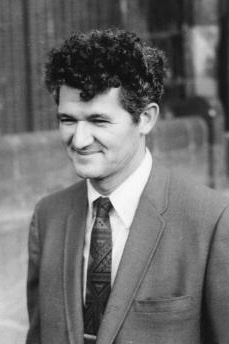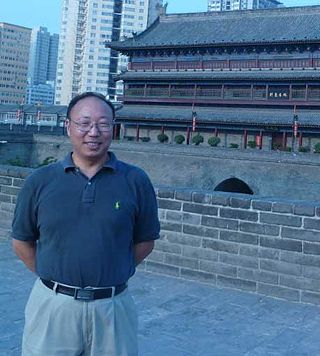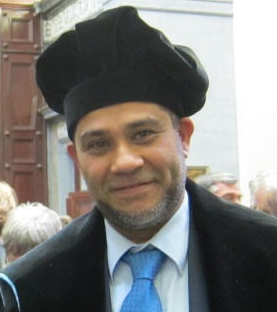
Stanisław Marcin Ulam was a Polish mathematician, nuclear physicist and computer scientist. He participated in the Manhattan Project, originated the Teller–Ulam design of thermonuclear weapons, discovered the concept of the cellular automaton, invented the Monte Carlo method of computation, and suggested nuclear pulse propulsion. In pure and applied mathematics, he proved a number of theorems and proposed several conjectures.

Monte Carlo methods, or Monte Carlo experiments, are a broad class of computational algorithms that rely on repeated random sampling to obtain numerical results. The underlying concept is to use randomness to solve problems that might be deterministic in principle. The name comes from the Monte Carlo Casino in Monaco, where the primary developer of the method, mathematician Stanislaw Ulam, was inspired by his uncle's gambling habits.
In cryptography, an S-box (substitution-box) is a basic component of symmetric key algorithms which performs substitution. In block ciphers, they are typically used to obscure the relationship between the key and the ciphertext, thus ensuring Shannon's property of confusion. Mathematically, an S-box is a nonlinear vectorial Boolean function.

Peter David Lax is a Hungarian-born American mathematician and Abel Prize laureate working in the areas of pure and applied mathematics.
Brosl Hasslacher was a theoretical physicist.
Vladimir Gilelevich Maz'ya is a Russian-born Swedish mathematician, hailed as "one of the most distinguished analysts of our time" and as "an outstanding mathematician of worldwide reputation", who strongly influenced the development of mathematical analysis and the theory of partial differential equations.
Dissipative solitons (DSs) are stable solitary localized structures that arise in nonlinear spatially extended dissipative systems due to mechanisms of self-organization. They can be considered as an extension of the classical soliton concept in conservative systems. An alternative terminology includes autosolitons, spots and pulses.

Themistocles M. Rassias is a Greek mathematician, and a professor at the National Technical University of Athens, Greece. He has published more than 300 papers, 10 research books and 45 edited volumes in research Mathematics as well as 4 textbooks in Mathematics for university students. His research work has received more than 21,000 citations according to Google Scholar and more than 6,000 citations according to MathSciNet. His h-index is 51. He serves as a member of the Editorial Board of several international mathematical journals.
Shashi P. Karna is a nanotechnology physicist who works for the United States Army Research Laboratory in Aberdeen, Maryland.
Richard W. Ziolkowski is an American electrical engineer and academician, who was the president of the IEEE Antennas and Propagation Society (2005), and a former vice president of this same society (2004). In 2006, he became an OSA Fellow. He is also an IEEE Fellow. He was born on November 22, 1952, in Warsaw, New York.
Dario Graffi was an influential Italian mathematical physicist, known for his researches on the electromagnetic field, particularly for a mathematical explanation of the Luxemburg effect, for proving an important uniqueness theorem for the solutions of a class of fluid dynamics equations including the Navier-Stokes equation, for his researches in continuum mechanics and for his contribution to oscillation theory.
Panayotis G. Kevrekidis is a professor in the Department of Mathematics and Statistics at the University of Massachusetts Amherst. Kevrekidis earned his B.Sc. in physics in 1996 from the University of Athens. He obtained his M.S. in 1998 and his MPhil and Ph.D. in 2000 from Rutgers University, the latter under the joint supervision of Joel Lebowitz and Panos G. Georgopoulos. His thesis was entitled “Lattice Dynamics of Solitary Wave Excitations”. He then assumed a post-doctoral position split between the Program in Applied and Computational Mathematics of Princeton University (10/2000–02/2001) and the Theoretical Division and the Center for Nonlinear Studies of Los Alamos National Laboratory (03/2001–08/2001). From 09/2001, he joined the Department of Mathematics and Statistics of the University of Massachusetts Amherst as an assistant professor. He was awarded tenure and promotion to associate professor in 06/2005. As of 09/2010, he is a full professor at the same institution. He is presently the Stanislaw M. Ulam Scholar at the Center for Nonlinear Studies at Los Alamos National Laboratory.

Albert C.J. Luo is a mechanical science, physics, and applied mathematics researcher who has been serving as a distinguished research professor at Southern Illinois University Edwardsville in Illinois since 1998.
George Curriden Baldwin was an American theoretical and experimental physicist. He was a professor of nuclear engineering at Rensselaer Polytechnic Institute and a scientist working at the General Electric Research Laboratory and at the Los Alamos National Laboratory. He wrote a book on Nonlinear Optics and authored or co-authored over 130 technical papers.
Muthusamy Lakshmanan is an Indian theoretical physicist currently working as Professor of Eminence at the Department of Nonlinear Dynamics of Bharathidasan University. Presently he is the DST-SERB National Science Chair awarded by the Science and Engineering Research Board, Department of Science and Technology. He has held several research fellowships which included Raja Ramanna fellowship of the Department of Atomic Energy, Alexander von Humboldt fellowship, Japan Society for the Promotion of Science fellowship, Royal Society Nuffield Foundation fellowship, and NASI-Senior Scientist Platinum Jubilee Fellowship. On 15 August 2021, he was conferred with the Dr. A. P. J Abdul Kalam Award by the Government of Tamil Nadu.

Sergej Flach is a theoretical physicist whose research has spanned a number of scientific fields in his career. With about 240 publications to his name, his research has been cited over 16,000 times giving him an h-index of 58 and i10-index of 174. He is a member of the American Physical Society, German Physical Society, Korean Physical Society, and New Zealand Institute of Physics. He is an editorial board member of Chaos (2016-) and was an editorial board member of Physical Review E (2009–2011).
Hans-Wilhelm Knobloch was a German mathematician, specializing in dynamical systems and control theory. Although the field of mathematical systems and control theory was already well-established in several other countries, Hans-Wilhelm Knobloch and Diederich Hinrichsen were the two mathematicians of most importance in establishing this field in Germany.

Magd Abdel Wahab is a Belgian academic, researcher, author and Imam of Islam. He is full professor and chair of applied mechanics at Ghent University, Belgium, where he is also the Head of Finite Element Modelling Research Group of Laboratory Soete.

Dionys Baeriswyl was a Swiss theoretical physicist and Emeritus Full Professor at the University of Fribourg in Switzerland, who worked on Condensed matter physics. Baeriswyl was known primarily for his contributions to the theory of strongly correlated electron systems. In particular, he had conducted fundamental work on conjugated polymer and other quasi-one-dimensional electronic systems, emphasizing early on the importance of electronic correlations in these systems. In addition, Baeriswyl was known for his work on variational wave function approaches to one- and two-dimensional correlated electron systems, applying them to the Peierls transition and the Mott transitions as well as to superconductivity in high-Tc cuprate. In the course of this work, he introduced the variational wave function known as the Baeriswyl wave function, which can be viewed as the strong-coupling complement to the Gutzwiller wave function. While the Gutzwiller wave function incorporates correlation effects into the free electron state, the Baeriswyl wave function incorporates itinerant electron movement into a localized, strongly correlated insulating state.







